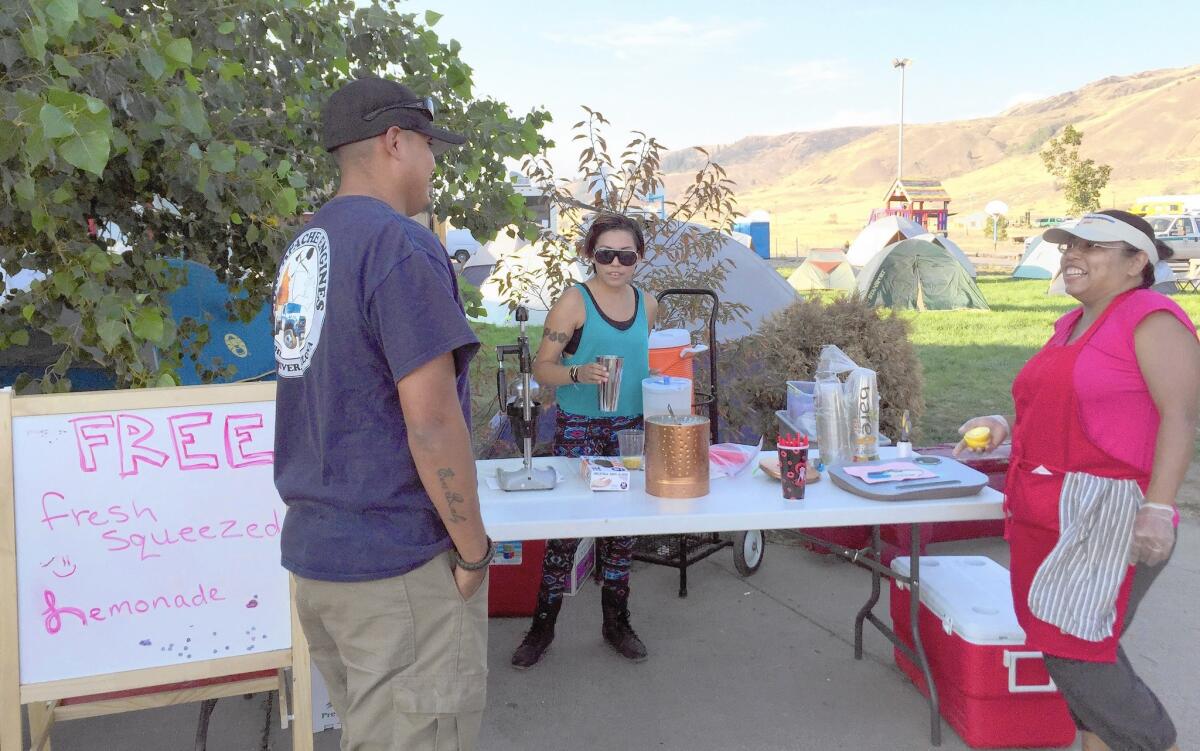Washington state reservation meets fire threat with generosity

Catherine Selam, right, now known as the lemonade lady at the community center in Nespelem, Wash., talks with a firefighter as her daughter Lexi makes lemonade.
- Share via
Reporting from NESPELEM, Wash. — The lemonade lady lives in subsidized housing on the reservation. She has lupus. Her joints ache. Her energy ebbs.
When the wildfires started a few weeks ago and smoke began filling the air, she went on the Internet to search for an air purifier. She could not afford a new one. She put a query on Facebook and received a response from someone many miles away. How much did he want for it?
His reply, “How about I just loan it to you?”
What kindness, she thought. She had never met him.
That gave her an idea: set up a lemonade stand. But instead of selling the lemonade, she’d give it away. “Pay it forward,” she said.
After all, there was suddenly no shortage of thirst to quench. Hour by hour, firefighting teams in coordinated T-shirts and fire-resistant pants — from Missoula, from New Mexico, from the Prineville Hotshots’ base in Oregon — had been arriving at the Nespelem Community Center. At least 800 people had rolled in by midweek, and that number was expected to rise.
Most of the year, the center’s gym is where members of the Confederated Tribes of the Colville Reservation engage in fierce games of three-on-three basketball or lift weights or study their dying languages, the ones many of them were forced to stop speaking decades ago. The tribes — there are 12 of them — used to move throughout what is now eastern Washington, fishing, hunting and gathering. They have been confined to this arid seam between the Okanogan and Columbia rivers since the government established the reservation in 1872.
Nespelem, a fleck of about 200 people in a valley surrounded by hills that turn golden in the summer, is where the tribal council meets and where it chose to build a $47-million government center, which is nearly complete. Protecting that investment is just one reason the tribes have been happy to temporarily convert the community center into a federally overseen operations base for wildfire management.
It is not the first time they have done so. About two-thirds of the 1.4-million-acre reservation is covered in timber, and about two-thirds of that is managed for commercial harvesting. At least some of the reservation burns almost every year when the weather gets hot and dry. Usually, a few hundred acres go, or maybe a few thousand. Last year, at least two fires exceeded 20,000 acres. That was uncommon. But this year has been historic.
The North Star fire started Aug. 13 and has shown no sign of stopping. As of Thursday, it had grown to more than 180,000 acres — far larger and more devastating than any blaze anyone’s parents or grandparents or great-grandparents could recall. Many tribal communities have been evacuated.
“Indian people are saying ‘What is the message? What is going on?’” said Veronica Redstar, who helps run the early education program at the tribal Head Start center. “‘What is it we need to learn from this?’”
The effort to fight the North Star this year has prompted an outpouring of support for the firefighters. It has also made Winona Ramos a very popular person.
She presides over the wide array of donations spread across tables outside the front door of the community center, next to the lemonade lady. Protein bars, water, acetaminophen, clean T-shirts, ChapStick. Take whatever you need, Ramos says.
“I’ve never been to a fire where there’s this much support for firefighters,” said Adam Stuart, who arrived this week after fighting a blaze in California. “I mean, fresh socks?”
Ramos showed some of the newcomers a beaded medallion, backed with buckskin, that she had made for her boyfriend, Nick Jim. He was out fighting the fire with three of her brothers.
“I’ve always been raised with my traditional culture,” she said. “In school, I was known as the traditional girl.”
A firefighter walked by.
“Afternoon,” he said.
“Afternoon,” Ramos responded. “That’s ‘way xast sxlxa’ in my language.”
The lemonade, of course, spoke a universal language. Every firefighter asked said they could not remember a single fire they had fought where someone served lemonade. Clarification: fresh-squeezed lemonade.
Here in the heat, beneath the smoke-screened sun, the lemonade lady was squeezing lemons, one by one, in a hand press. She then blended the juice with sugar, added water and ice and shook it, like it was nothing at all.
She told those who asked that her name is Catherine Selam, and that she goes by Cat. She told them three generations of her family were involved in the effort.
“My mom sponsored the lemons,” Selam said. “I got together the tools and all that, and then my daughters perfected the recipe.”
Asked why she was making free lemonade for firefighters she has never met and probably will never see again, Selam’s daughter Lexi said, “Because my mom is crazy.”
Maybe so, Selam said.
“It’s just a little luxury they’d never have.”
More to Read
Sign up for Essential California
The most important California stories and recommendations in your inbox every morning.
You may occasionally receive promotional content from the Los Angeles Times.














